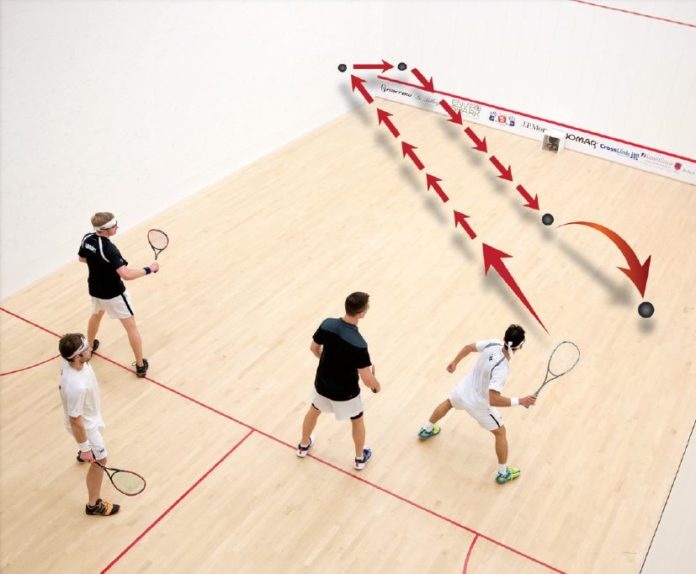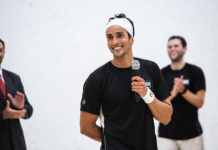The reverse corner is the foundational shot in hardball doubles. More points are ended with the reverse than any other short shot. Since it is a rarity in softball singles, many young players have trouble hitting it consistently. We asked a half dozen doubles legends to tell us how they approached hitting the reverse.
Jamie Bentley
The reverse corner is a shot that really can be hit from anywhere, even from deep in the court, but you may have to hit some wide cross-courts to set it up. After you hit it, your opponent’s response will likely go to your partner. The bad reverse, now known as the reverse three-wall, is also a great complement to the reverse. The reverse corner can also be hit off a reverse corner, if your opponent hits a weak one.
Jamie Bentley captured more than seventy pro doubles titles.
Joyce Davenport
The reverse corner—“that doubles shot” as softballers refer to it—is a shot that hits the opposite side wall near the front corner and then the front wall. Singles players seldom use the shot, but it is a terrific hardball doubles shot, given the length of the doubles court and that the shot often crosses in front of the opponent, delaying their run to the ball. I have a strong preference for the tight reverse, which hits very close to the front wall and does not come off the opposite side wall. It is easier to hit than players realize and sometimes can produce lucky winners as the ball accidently hits the front wall first. Safety is a key issue: the shot should not be hit if you believe someone is in the way. The reverse corner must be an integral part of your attacking game in doubles.
Joyce Davenport has won thirty-five U.S. national doubles titles in the past fifty years.
Stephanie Hewitt
Doubles is a game of angles, with the reverse being one of the most effective attacking shots. Ideally, when hitting the forehand reverse, your opponent is behind you and off of your right hip if you are on the right wall. I hit the ball stepping forward on my front left foot with the ball in front of me. I aim for the front left corner, hitting the left side wall then front wall about an inch above the tin. The ball should be hit firmly and flat and bounce twice before hitting the right-side wall. Like any ball hit short, a reverse should always be followed up by both you and your partner.
Stephanie Hewitt has won seventeen pro doubles titles on the WSDA pro tour and seven U.S. national doubles titles.
John Russell
The reverse corner is the best way to finish a rally. I try to hit the side wall as close to the front wall as I can. You actually have a reasonable margin of error, because if you catch the ball a little late and hit the front wall first instead, it can also be a very deceptive and effective shot. If I’m hitting the reverse from above my shoulder, I’ll really open my racquet face and come around the outside of the ball, breaking my wrist at the last second to take the pace off of it and bring the ball down. Anything below my shoulder, I generally try to hit harder and flatter so that the ball stays low to the ground.
John Russell has won twelve SDA pro tour titles, including two World Doubles championships, and earned the world No. 1 ranking in June 2019.
Peter Briggs
The reverse corner is the number one attacking shot in doubles. You have to hit the reverse corner with a short backswing and an accelerated, sharp follow through to gain maximum spin to lay the ball down. A short backswing makes it easier to prevent your shot coming off the third wall. If I am right handed and hitting a reverse from above my head, I “peel the orange” at two o’clock on the ball and if I am hitting the reverse from waist high off the ground, I pull across the inside of the ball. Both techniques allow the striker to put elliptical spin on the ball so it will run more parallel to the front wall after hitting the side wall.
Peter Briggs was inducted into the U.S. Squash Hall of Fame in 2006.
Narelle Krizek
The reverse can be used to move your opponent up into to the front part of the court which then opens up the back corners, or it can be used as an attacking winner when your opponents have left the ball short. Whether I’m hitting it off the bounce or as a volley, I tend to hit mine harder, rather than a soft touch boast. Make sure to move your feet and transfer your weight onto your front foot, with your contact point being in front of this foot. Have your racquet ready—then you can quickly open your racquet face to take the ball early. Aim right where the front wall and side wall meet, and about three inches above the tin to give room for error. Always try to have it bounce twice before hitting the opposite side wall.
Narelle Krizek was ranked No. 1 on the WSDA pro tour in 2009-2015.





